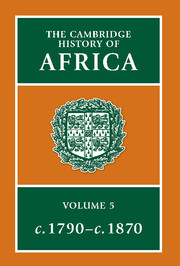Book contents
- Frontmatter
- Introduction
- 1 Egypt and the Nile Valley
- 2 Ethiopia and the Horn
- 3 The Maghrib
- 4 The nineteenth-century jihads in West Africa
- 5 Freed slave colonies in West Africa
- 6 West Africa in the anti-slave trade era
- 7 The forest and the savanna of Central Africa
- 8 East Africa: the expansion of commerce
- 9 The Nguni outburst
- 10 Colonial South Africa and its frontiers
- 11 Tradition and change in Madagascar, 1790–1870
- 12 Africans overseas, 1790–1870
- 13 Changing European attitudes to Africa
- Bibliographical Essays
- Bibliography
- Index
- References
1 - Egypt and the Nile Valley
Published online by Cambridge University Press: 28 March 2008
- Frontmatter
- Introduction
- 1 Egypt and the Nile Valley
- 2 Ethiopia and the Horn
- 3 The Maghrib
- 4 The nineteenth-century jihads in West Africa
- 5 Freed slave colonies in West Africa
- 6 West Africa in the anti-slave trade era
- 7 The forest and the savanna of Central Africa
- 8 East Africa: the expansion of commerce
- 9 The Nguni outburst
- 10 Colonial South Africa and its frontiers
- 11 Tradition and change in Madagascar, 1790–1870
- 12 Africans overseas, 1790–1870
- 13 Changing European attitudes to Africa
- Bibliographical Essays
- Bibliography
- Index
- References
Summary
EGYPT AND THE NILE VALLEY IN THE LATE EIGHTEENTH CENTURY
In the last decade of the eighteenth century, the political condition of Egypt and the Nilotic Sudan was not far removed from anarchy. Egypt was still, as it had been since 1517, a province of the Ottoman Empire, but it was no longer under the effective control of the sultan. Since the early seventeenth century, the power of the Ottoman viceroy had been eroded until he was no more than a figurehead. The country was dominated by a military elite composed of the officers of the Ottoman garrison-corps (especially the Janissaries) and a group of grandees, the beys, most of whom were members of Mamluk households, and were of Circassian, Bosniak or other alien origin. The whole political structure was deeply riven by faction. By the middle of the eighteenth century, a group known as the Qāzdughliyya, after the Mamluk household which formed its nucleus, had triumphed over their rivals, only to split up into competing personal factions. Between 1760 and 1772, the most capable and ruthless of the Qāzdughlī leaders, Bulut Kapan ‘Alī Bey (often called al-Kabīr, ‘the Great’), established a kind of dictatorship. After he had been overthrown, and eventually killed (in 1773), the primacy in Egypt passed to his own former mamlūk, Muhammad Bey Abu’l-Dhahab, whose death in 1775 was followed by a revival of faction-fighting. After many vicissitudes, including an Ottoman expedition in 1786–7 intended to restore the sultan's control over Egypt, brāhīm Bey and the ultimate victors in this contest were two men, I Murād Bey, who established a somewhat uneasy duumvirate.
- Type
- Chapter
- Information
- The Cambridge History of Africa , pp. 13 - 50Publisher: Cambridge University PressPrint publication year: 1977

